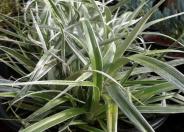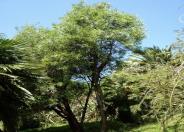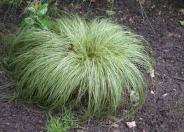
Common name:Geranium
Botanical name:Pelargonium drummondii
A perennial herb found as an erect or semiprostrate shrub, Pelargonium drummondii may be 3-16" in height. The flowers are light pink, but a darker colour at the center, splotchy and veined in appearance. The oblate cordate leaves are generally large and succulent. P. drummondii is distinguished from a similar widespread Australian species P. australe by the presence of a prominent branching perennial stem, which is generally absent in P. australe. However, young plants are likely to be indistinguishable by morphology alone. It does best in full sun with well draining soil. They need regular water during hot spells. Pelargoniums usually bloom during the summer, tolerating heat but not frost.
The species was first described by Turczaninow in Bulletin de la Société Impériale des Naturalistes de Moscou.[1] The type specimen was collected by James Drummond, whose name is given in the specific epithet. It is described as native, not endemic., one of several Pelargonium occurring in Western Australia. The similar, but usually scented, South African species P. capitatum is also found throughout many Southwest Australian regions, although these were known to have been introduced after colonization by Britain.

Common name:Brown Sedge
Botanical name:Carex testacea
The testacea variety is an evergreen perennial that reaches 2' tall bearing very narrow, coppery brown leaves splitting to hair-like threads at their tips, and continuing to grow to 4-8' in length.
This plant should be grown in sun with little or no summer watering. -Monterey Bay Nursery

Common name:Shore Astelia, Wharawhara
Botanical name:Astelia banksii
Evergreen perennial from the lowland and coastal forests of the North Island of New Zealand that grows to 3 to 4 feet tall. The silvery/pale-green foliage of this species is narrow and slightly recurved. As with other Astelia, the male and female flowers are on separate plants (Dioecious), neither are showy and are usually down in the foliage. Plant in full coastal sun to light shade in a well draining soil. Although this plant can take extended periods without irrigation, it looks better if given occasional water. Hardy to 20-25° F - our large specimen plant in the garden was unharmed during the January 2007 freeze with 3 nights in a row at 25° F. A great plant for a container, a specimen or for a mass planting in the garden. There are 25 species of Astelia, 13 endemic to New Zealand - this coastal species in found on the North Island from the North Cape to Taranaki and Hawke's Bay. The name of the genus comes from combining the Greek words 'a' meaning "without" and 'stele' meaning a "trunk" or "pillar" in reference to these plants not forming a stem or trunk. The specific epithet authored by British botanist Allan Cunningham in 1837 honors British naturalist and botanist Sir Joseph Banks. The fruit of this plant is called Wharawhara in New Zealand and the town of Kaiwharawhara, a seaside suburb of Wellingoton (also known as Kaiwarra), takes its name from the abundance of this plant there. The Astelia have long been considered part of the Liliaceae family but most recent treatment puts them in the Asteliaceae family in the Asparagales order with the relatively unknown genera Collospermum, Milligania and Neoastelia.

Common name:Tree Hakea
Botanical name:Hakea eriantha
Medium to tall shrub or small tree (6-24') with cream, white or pink flowers in spring-summer. Suitable to most well drained soils in full sun or semi-shade. Grows well under eucalyptus. Suitable for hedge or screen. Tolerant of heavy frost. Originally from Eastern Australia, this shrub is drought tolerant once it's established. Foliage is shiny green, long and narrow, 5" long and 1" wide. Easy to grow, used as a background shrub. Birds love this shrub.

Common name:Frosty Curls Sedge
Botanical name:Carex 'Frosty Curls'
'Frosty Curls' is an attractive grass sedge, that stays less than 1' tall and 2' wide. It can be planted in full sun along the coast but needs afternoon shade in warm inland valleys. It needs regular watering and can be planted close to ponds or boggy areas. Rake the "hair" once in a while. This plant needs regular watering. Foliage is thin, silvery green, evergreen and shoots from a center point and recurves. Flowers are inconspicuous.
Designer: UC Berkeley
Photographer: Vicki Anderson
Maintain a two to four inch layer of mulch on the soil surface to reduce weeds, infiltrate rain water, and reduce compaction.
Develop healthy soil for plants that are vigorous and naturally pest-resistant.